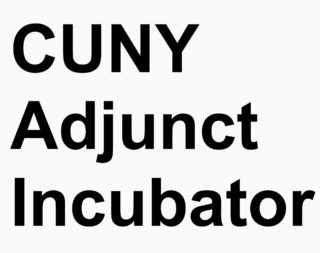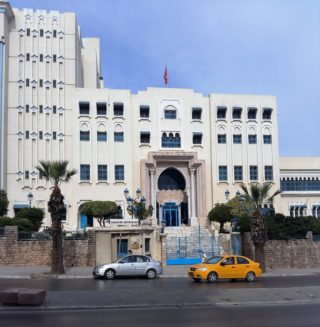Corinna Mullin
January 2008 saw the start of a major uprising in Tunisia’s Gafsa mining basin. Unemployed youth, dissident trade unionists, family members of the unemployed, teachers as well as activists and workers from other sectors of the economy took to the streets to express their discontent with the corrupt hiring practices of the state-owned Compagnie des phosphates de Gafsa (CPG) - and the impact of the mining industry’s neoliberal restructuring on unemployment and deteriorating labor conditions. The protestors also drew attention to the politics of exclusion, dispossession and resource extraction that have historically resulted in Gafsa’s regional marginalization. The uprising ultimately buckled under the violent state response. In late September 2018, several victims of this repression finally had their day in day in court as their cases were brought in front of a specialized criminal chamber established under Tunisia’s ‘transitional justice’ process.[i] Yet the structural causes of both the 2008 uprising and its brutal repression have yet to be addressed.
Much important analysis of the uprising has emerged in recent years from the perspectives of labor and social movement theory, often pinpointing it as an important inaugural moment in a longue durée treatment of Tunisia’s more internationally recognized 2010-2011 revolt. Considering the role of state violence in putting an end to the Gafsa uprising, as well as to shaping the trajectory of the 2010-2011 revolt and other social mobilizations across the country in its aftermath, what additional insights might be gained from analyzing the Gafsa uprising through the lens of the security state?
Guided by this question, my research examines the Gafsa uprising as one of the principle post-colonial conjunctures through which the central contradictions of the Tunisian security state have been exposed, and its mechanisms retrenched, rearticulated and resisted. This research comes out of and builds upon the multi-method qualitative research I conducted during the five years (2012-2017) I lived and worked in Tunisia. It will ultimately form part of my upcoming book, which traces a genealogy of Tunisia’s imbrications within racialized imperial security architectures. Focusing on the case study of Tunisia, the book examines the mechanisms through which global south states have, in large part, become imbricated within imperial security architectures. With its roots in the era of European imperial expansion and French colonial rule, the Tunisian security state has functioned to secure markets for European goods and access for European capital. It has enabled the conquest and expropriation of land and natural resources and the management and repression of political dissent. Most importantly for this part of my research, the Tunisian security state by design (re)produces the stratified vulnerabilities required for colonial-capitalist exploitation and regulation of labor, as well as various other forms of value extraction. Though by no means its only mechanism, violence has been central to the workings of the security state.
Rather than viewing this violence as exceptional or in excess of the normal workings of the state [ii], this research assesses the ‘law preserving’ and ‘law making’ role of state violence, as well as the potential for resistance itself to engage in ‘law making’ [iii]. Analysis of the discursive context and battles over representation are in many ways as fundamental as underpinning material relations to understanding these dialectically connected modes of law-making.
Whereas dominant narratives of popular mobilization are designed to rationalize and normalize state violence in order to maintain power, dissident representations contribute to both the form and content of ongoing and future subaltern struggles. Rather than begin with the latter, I decided to start my research for this project in the National Archives to see what they might reveal not only about how security state power operates in these moments of ‘crisis’, but how it justifies itself as well. As critical scholars have long argued, official archives are hardly neutral sources for knowledge production. Instead, they are sites of administrative, political and cultural power in the service of colonial/imperial/capitalist/repressive state interests. They also perform an important epistemological function, in shaping not only the kinds of knowledge available but even the criteria for determining legitimate knowledge.
Though limited in its ability to affect socio-economic structural change, Tunisia’s 2010-2011 revolt has impacted state institutions in terms of both personnel and, to a certain extent, organization. I wondered to what extent the transformations engendered by this popular mobilization would be reflected in the collections related to the Gafsa uprising held by the Tunisian National Archive. Despite some tangible changes at the levels of public engagement and accessibility, it seems declassification and archival expansion- at least regarding this particular event- has yet to occur.
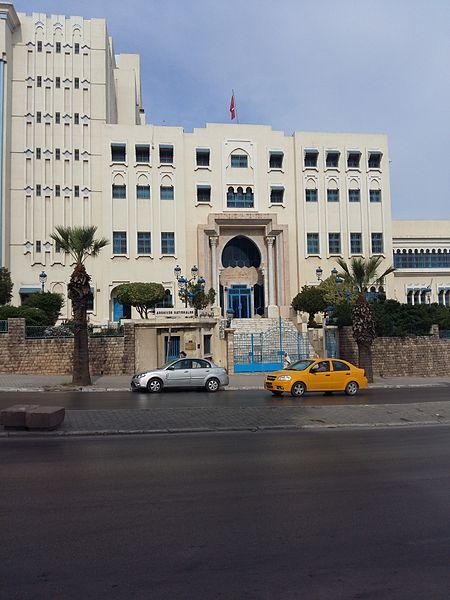
The available collections in the Tunisian National Archive (a part of which is the National Library, charged with collecting, processing, and safeguarding official documents - in particular manuscripts and periodicals) concerning the 2008 uprising remains circumscribed by numerous ‘silences’ and ‘exclusions.’ [iv] These are somewhat mitigated by the apparently haphazard inclusion of subaltern accounts of historical episodes, for example in the form of books published in the aftermath of the uprisings. In my archival search for material related to the 2008 Gafsa uprising and the repression that followed, I found very little divergence between official accounts, articles in newspapers that served as mouthpieces for the single-party government and its long-standing president Zine El Abidine Ben Ali, or even at the time nominally oppositional periodicals such as the monthly tract of the dominant syndicate (Union Générale Tunisienne du Travail- UGTT), As Shaab.
The timeline one gleans from the official narrative of the Gafsa uprising follows a familiar trajectory: first, government denial that anything of significance is unfolding, followed by attempts to dismiss and disparage those involved, then grandiose promises to address the problem, and finally, further erasure and denial. What is interesting, though not altogether surprising for anyone familiar with the history of the UGTT––a trade union subjected to repression and co-optation, historically caught between ‘autonomy and dependence’[v] vis-à-vis its organization and relations with the single-party state––is As Shaab’s almost complete six-month-long media blackout of the Gafsa uprising.
I managed to locate in the archives one drastically different perspective: a book published post-2011. Written by Hafidh Tabbabi, Intifadhat al Hawdh al Manjami bi Gafsa (2008) locates the Gafsa uprising within the broader history of nationalist and labor resistance dating back to colonial times (‘deep causes’), as well as the more immediate causes to which the Gafsa protesters drew attention.
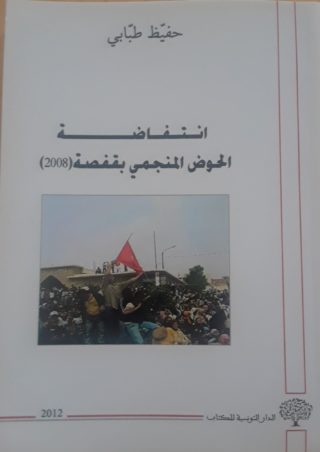
e
Yet such accounts of contestation and resistance—both in relation to colonial and post-colonial power—remain in large part confined to the margins of the archives, if they are present at all.
How does one piece together and tell a different story to that presented by power? Despite radically different contexts, Saidiya Hartman’s account of the obstacles she faced in trying to parse a narrative of resistance to racial terror and subjugation from the official accounts of slavery may be useful. She explains that this process might require:
‘excavations at the margins of monumental history in order that the ruins of the dismembered past be retrieved, turning to forms of knowledge and practice not generally considered legitimate objects of historical inquiry or appropriate or adequate sources for history making...’[vi]
Through my research I was also able to explore a rich and extensive reservoir of non-archival material written on the 2008 Gafsa uprising, which could be considered part of what Max Ajl refers to as a ‘historiography of revolt’ in Tunisia.[vii] This includes written and visual material produced by journalists, activists and solidarity organizations both inside and outside of Tunisia, oral accounts of individuals who participated in the uprising, books and articles penned by critical Tunisian and international scholars. While the unofficial reservoir is crucial to understanding the historical roots, causes and development of the uprising as well as its securitization and violent repression, the official archive provides insight into the functioning of discursive power—how important control of the narrative is to the (re)production of the security state.
Gafsa and the colonial roots of ‘underdevelopment’
Similar to other socio-political conjunctures through which the security state has been retrenched and resisted, the backstory to the 2008 Gafsa uprising can be found in the country’s colonial past and early state building. To truly grasp the significance of this history requires moving beyond the official narratives, which claim a clean break between the country’s colonial and post-colonial pasts.
Located in the southwest—one of the most socio-economically and politically marginalized regions of Tunisia—the Gafsa mining basin (including the towns of Redeyef, Oum El Araïes, M’dhila and Métlaoui) is central to understanding the relationship of the security state to the extraction and, in large part, export of Tunisia’s natural resources and surplus value. Gafsa has been at the core of the region’s ‘underdevelopment’, in the sense that Walter Rodney used the term to signify the relational nature of capitalist accumulation and the racialized and spatialized ‘depriv[ation] of societies of the benefit of their natural resources and labour.’[viii] The extraction and export of phosphates has contributed to re/producing the geographical, gender and class inequalities upon which the Tunisian economy has been built from the colonial to post-colonial period. As a result, Gafsa has also been central to the development of the security state architecture, as particular apparatuses had to be deployed to enable and protect the economic activities around the phosphate industry, even in the face of inevitable resistance.
Established in the late 19th century during the French colonial era, the Compagnie des phosphates de Gafsa (CPG) was one of the largest employers in the country, attracting workers from the south and interior of the country, as well other Maghrebi labor. It both contributed to as well as reflected ‘the emergence of a new working class, generally composed of former farmers and nomadic peoples’ displaced from their land by colonial-capitalist modes of development.[ix] Demonstrating the strategic importance of the region to French economic interests, the area surrounding the mines was maintained as a military zone, with the head of the CPG a military appointee.
The class composition of the Gafsa mining region made it a natural source of support and social base for the Gafsa-Sfax-Kerkennah “southern axis”—the backbone of the national trade union movement.[x] It was the site of major labor contestation during the depression years due to high unemployment, real-term wage depreciation, despite the discovery of rich new mineral deposits, and recurrent food shortages. Many of these worker actions took on nationalist hues, especially those initiated by the militantly anti-colonial Confédération générale des travailleurs tunisiens (CGTT). Founded in 1924, the CGTT was created as an alternative to the European settler-dominated Confédération Générale du Travail (CGT), which had failed to treat as a pressing labor issue the racialized hierarchy of remuneration and unequal treatment of Tunisian versus European workers.[xi] The increased labor mobilization was paralleled by an accelerated militarization of Tunisian colonial policing.[xii]
Though the French had established numerous police units to manage and control every aspect of colonial life, in the face of protests, strikes and peasant uprisings, the army and paramilitaries were called in to back up the repressive capacity of the ‘civilian’ state. The 1936-1937 period saw heavy colonial repression, reaching an apex in March 1937, when sixteen miners were killed at the Métlaoui mine complex. Yet it could not stop the tide of anti-colonial mobilization. It was in this context that the Tunisian national trade union, the UGTT, was founded in 1946 under the leadership of former CGT activist Farhat Hached and Ahmed Tlili, who hailed from Kerkennah and Gafsa respectively. From its origins, the UGTT leadership maintained a close relationship with what was the leading nationalist political party – the Neo-Destour.[xiii] Despite some political differences, the UGTT often worked together with the CGT and the more openly communist and internationalist Union syndicale des travailleurs de Tunisie (USTT), leading to increased labor resistance during this period, with 159 strikes in the Gafsa mining basin between 1946 and 1956.[xiv]
Memories of the 1937 labor struggles along with recollections of the region’s role in armed anti-colonial struggle and state repression would continue to inform the strategies of both the security state, in controlling labor and facilitating extraction, as well as of the workers, in their numerous mobilizations throughout the post-colonial period. Popular narratives inform us that many of Gafsa’s residents believe that the region’s historical neglect has much to do with the post-colonial Tunisian state’s ‘fear’ of the region’s rebellious character, in particular, as it is known that Gafsa was a stronghold of support for Bourguiba’s former nationalist partner-turned-foe, Salah Ben Youssef.[xv] The latter’s adherence to a more radical decolonization project—rooted in a pan-Maghreb, pan-Arab and Third Wordlist vision—as opposed to his rival’s pro-west, ‘gradualist’ agenda, contributed to his eventual exile and assassination.[xvi]
The 2008 Gafsa uprising: a chronology of resistance and repression
The 2008 Gafsa protests occurred during a period of increased capitalist expansion. The structural violence entailed by this process has been largely evaded in dominant narratives peddled by international financial institutions, their western backers and domestic authorities. With the roots of its modern state formation in the era of European imperialism and French colonial rule, and its post-colonial development under the shadow of US empire and other western imperial influences, Tunisia, unlike many of its neighbors, has generally—apart from a short-lived and top-down ‘socialist experiment’—adhered to a liberal/‘modern’ and pro-west economic/political orientation. Yet by virtue of it being a North African state at a time when socialism, Third Worldism and Arab nationalism were the dominant ideologies of development in the Global South, the policies pursued by Tunisia’s first post-independence head of state reflected certain aspects of state-led development even in the face of external and internal pressures to expedite liberalization. However, the years leading up to 1986 witnessed increased repression of socio-economic mobilization in the face of state retraction/restructuring, a process accelerated with the adoption of the IMF imposed 1986 structural adjustment plan.[xvii] Ben Ali ruled through a combination of state violence and co-optation, indirect encouragement of emigration [xviii]—in particular to Europe (as a means to relieve unemployment and increase remittances/inflows of hard currencies, while also subsidizing European capital through the provision of cheap labor)—and western-backed ‘development’ discourses and programs that gave the illusion of addressing deep-rooted social and economic issues, while increasing inequality and extending government control.[xix]
Despite the hardening grip of the security state, both everyday and more sustained forms of contestation persisted as the population suffered from growing unemployment and/or precarious employment, increased inflation and (public and private) indebtedness, environmental degradation and reduced social services.[xx] However, until 2008, social mobilization failed to reach the level of contestation witnessed in previous waves of outrage—including the 1968 leftist and anti-imperialist university mobilization,[xxi] the 1978 general strike, or the 1984 bread uprising, which also had its roots in the country’s marginalized southwest region before making its way northeast to the capital.
Nationalized at independence and later merged with the Groupe Chimique Tunisien (CGT), the CPG became the largest employer in the region. Its investments in infrastructure and social goods for the mining towns, including schools, health care, youth facilities and supermarkets, meant it was an integral part of both the social and economic fabric of these communities. Agricultural work declined in significance not only due to small farmer’s lack of access to land but also to the deteriorating ecological context resulting from the chemically harmful nature of the CPG’s processing facilities and contamination of groundwater quality.[xxii] This explains how most of the region’s economic activity came to be centered around the phosphate mines.[xxiii]
Mirroring other sectors of the economy, the economic restructuring of the CPG at the behest of the international financial institutions hit youth employment particularly hard. Already rolling back its social program spending, starting in 1985, the CPG implemented its second wave of ‘modernization’ (the first one occurred during the colonial era and was also met with labor resistance). The World Bank intervened to fund these ‘strategic reforms’ as part of its program to ‘upgrade’ the Tunisian economy.[xxiv] Close to 10,000 positions were eliminated—a 75% reduction in employment. That these cutbacks took place at a time when phosphate prices were rising on the global market—resulting in super-profits for the CPG—was the source of much ire in the local communities that depended on the company for their livelihoods. The effects of this restructuring were not only felt in terms of employment, but they also ‘further exacerbated’ clientelistic hiring practices, corruption as well as environmental degradation.[xxv]
Both the dislocations caused by the neoliberal restructuring of the mines and the resistance they engendered are ignored in official Tunisian state narratives. The reservoir of non-official accounts provides a more accurate chronology. Hunger strikes, contestation in the regional sports stadiums and other forms of protests by largely unemployed youth began in 2007.[xxvi] On January 5th 2008, when the CPG announced its new hires, the six-month protest movement took off in earnest. Mass actions began to unfold across the entire mining basin region. Several marches and hungers strikes were organized, camps were erected in strategic locations to halt all economic activities related to the phosphate industry, including tents blocking the movement of trains and trucks between quarries and factories. Sit-ins and demonstrations obstructed the entrances of government buildings to disrupt official activities. Protesters also expressed anger towards the Regional Secretary General of the UGTT, for having benefited from CPG corruption and for failing to support the mobilizations.[xxvii]
The most vocal constituent of the mobilizations were unemployed graduates—many of whom participated in the founding of the newly created and heavily repressed Union des Diplômés Chômeurs (UDC)—whose employment opportunities were further undermined by the restructuring. But there were also dissident local union leaders and rank and file members, leftist activists, high-schoolers concerned about future job prospects, and the families of unemployed youth ‘calling upon the authorities to give their children work’.[xxviii] The Communist Tunisian Workers’ Party (Parti Communiste des Ouvriers de Tunisie- PCOT) came out in support of the movement early on, providing updates of the events through its internet site (albadil.org) as did local branches of the national human rights organization (La Ligue tunisienne des droits de l'homme- LTDH). As arrests of activists increased, the wives and families of detainees joined the protests, demanding that the authorities release their husbands, brothers and children. This video, produced by a Tunisian support committee (Le comité tunisien de soutien à la population du bassin minier de Gafsa- CRLDHT) forms part of the popular history of the 2008 Gafsa uprising. The film features interviews with many of the family members of those detained and subjected to state violence. In the words of Leila Khaled, wife of one of the detainees:
‘the [peaceful] protests focused on the demands of the right to work, dignity, and social justice. Then the situation was turned upside down on April 7th; there were many arrests ... the security forces attacked the local union and violently attacked everyone. The inhabitants were all in the streets watching, and they were beaten. On the 8th of April, they arrested my husband, Bechir, and then they arrested hundreds of young people from Redeyef. There was even a child, a fifth grader, who was detained and subjected to the worst forms of torture. We, all the inhabitants of the city of Redeyef, marched in protest on the 9th and 10th of April ... we demanded the immediate release of our loved ones because they did not commit any mistake or crime. They are people who demanded respect for their rights ...they are all patriots... (Author’s own translation)
In their expressed grievances towards the CPG, protestors also elaborated a critique of the modern-capitalist development model that has been imposed on the country by various external and internal actors from the colonial to the post-colonial eras. As the participants in the sit-in of the Local Labor Union of Redeyef proclaimed in their official statement to the population of Redeyef (Bayan ila Ahali al-Redeyef) [xxix]:
‘At a time when our youth suffers from destitution, poverty and unemployment, the towns in the Sahel are receiving factories and institutions where nobody works. Our youngsters, our daughters, our families are forced to emigrate and to scatter, in search for work. Where is our share of the development? Where has our share of the national wealth gone to? Where is the just recompense for our participation in the building of the nation and of its economy, after more than 50 years?’
Gafsa and the security state: return to colonial policing
Similar to former mass mobilizations, the 2008 Gafsa uprising elicited a violent response from the state. Many protesters were beaten and several were killed. Rather than hold to account the responsible security officials, the protestors themselves were subjected to further carceral and administrative violence in the form of arrests and charges that evoked French strategies to delegitimize and depoliticize the anti-colonial resistance and deflect the blame for violence from the perpetrators to the victims. These charges included: participation in an attempted coup, violence against and threats to public officials, possession of prohibited weapons, assault, public drunkenness and disturbance of public order. After what amounted to show trials, many (especially the protest leaders) were given inordinately long sentences and were subjected to torture and other forms of mistreatment in prison.
There were many other echoes with colonial era policing, including the strategy to ‘fragment’ the movement through attempted cooptation of certain activists, on the one hand, and, on the other, securitized containment, involving police encirclement of towns and cities as well as checkpoints on regional roads and major arteries.[xxx] There were also violent raids on communities, using tear gas grenades and mass arrests, a sort of ‘collective punishment, aimed at generating terror, at chocking the feeling of resistance and at breaking the ties of solidarity within the population.’[xxxi] Some protests were met with extreme violence, including the use of live fire. Also, similar to colonial protest policing, the military was eventually called in as backup to occupy the city of Redeyef.
Following the bloodiest day of the police repression on June 6th, in which one young man was killed and more than 20 protestors injured, the state-aligned newspapers were silent. The first acknowledgement I found in the national archives is on June 9th, with articles containing the statements of ‘loyal opposition’ parties expressing their condemnation of the violence—not of the state, but of the protesters. In this page 4 article from La Presse, these parties, while recognizing the legitimate aspirations of the people of Gafsa ‘for more progress and well-being’ in the mining basin, stress that this ‘should in no way justify the acts of violence perpetrated by some’ of the protestors, as what was needed at this time was ‘stability, security and social peace in the country.’

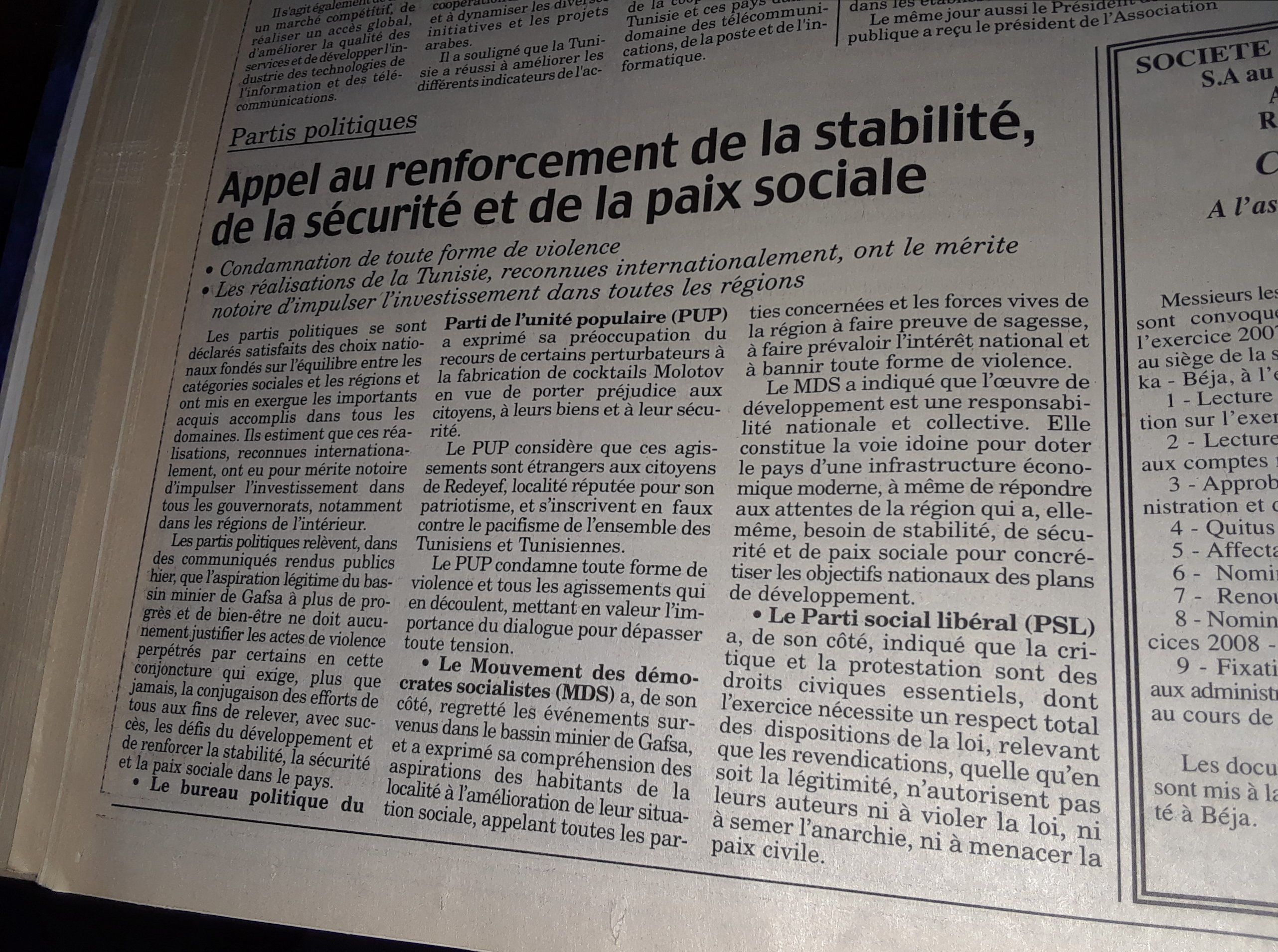
Consequent to the June repression, Ben Ali attempted damage control by announcing the replacement of the Gafsa governor, as well as the dissolution of the Gafsa municipal council. Following what had become the norm in the face of revolt, the president also announced a major investment project for the region, including 944 million dinars (499 million euros) to generate the creation of 9000 permanent jobs, the building of industrial complexes in each of the mining basin towns, and 300 million dinars for re-training programs so that youth could work in newly created companies designed to reduce unemployment. Like the other development promises Ben Ali had made before, these kinds of measures were designed as stopgaps and- even if implemented fully- could not possibly address the movement’s demands for structural change and dignity.
The afterlives of the 2008 Gafsa uprising
On the one hand, it could be said that the state and its western backers were successful in the end, as the neoliberal restructuring of the CPG went ahead as planned, and the stratified vulnerabilities of an already marginalized and exploited workforce were further entrenched. Yet, on the other hand, many lessons were learned that laid the groundwork for the 2010-2011 revolt and other future mobilizations. Activists in the region cultivated a better understanding of the tactics and strategies of the security state, and this informed their future organizing. In many ways, 2008 was, in Hèla Yousfi’s words, a ‘dress rehearsal’ for the later uprising.[xxxii] The UGTT realized that its prized place among workers would be permanently undermined if the union failed to come out in support, once again, of a major social movement. There was also a growing recognition within the labor movement and others organizing in oppositional circles of how important the unresolved issue of uneven (under)development was to addressing the structural issues at the heart of the various social movements over the years. Though natural resources (the terms of their exploitation, production and distribution, as well as ecological dimensions) and the regulation of labor are independently central to understanding this issue, it is the plight of the unemployed that, in fact, connects the two. The region’s high level of unemployment can be traced back to other unresolved (neo)colonial legacies and its impact on rural populations. Many of the unemployed come from former peasant families dispossessed of their land due to changes to land tenure regimes. Communal land was divided and registered; the ‘land market’ was expanded; speculation worked in tandem with predatory lending, which led to growing indebtedness. [xxxiii] Mechanization and capital-intensive farming, [xxxiv] environmental degradation, privatization, as well as the decline of Tunisia’s productive base during the neoliberal era all contributed to this situation. The larger the unemployed labor pool, the easier it is to exploit and discipline labor.
Finally, the Gafsa uprising forced acknowledgement of the role of the unemployed as central political actors. Whether in Gafsa or Kasserine, Tunis or Sidi Bouzid (where 2010-2011 uprising was sparked), Tunisia’s unemployed—like the unemployed across much of the globe—have so often been marginalized in scholarly analyses of ‘historic blocs’ and social movements. They have also been overlooked by much of organized labor and the left, criminalized and/or disposed of by the state for the actual/potential threat they pose to public order and private property, and exploited by capital as a permanent pool of cheap labor that maintains low wages. As Angela Davis reminds, conditions of racial capitalism are marked by an ‘internal dynamic’ of stratified vulnerability, in which whole segments of the population are unemployed by design; thus, it would be misguided to overlook the potential role of the ‘lumpenproletariat in revolutionary struggle. ’[xxxv]
Perusal of the official and popular archives provides new insights into the mechanisms through which the imperially imbricated Tunisian security state has been entrenched, rearticulated and resisted at particular socio-economic and political conjunctures. Reinforcing analysis in other parts of my upcoming book, in the case of the Gafsa uprising I have also found that the greater the security state’s contradictions become, the more repressive its colonial policing and the more excessive its legitimizing narratives. Yet it is precisely at these moments of excess that the contradictions of the security state may be exposed and contested—in the form of strikes and uprisings, as well as through dissident memories and narratives that work to demystify the tools of power. Similar to the colonial era, the Gafsa mining basin continues to be a source of resistance—to both global and local capital in their exploitation and dispossession of already marginalized communities—and an alternative means of imagining ‘development’ outside of colonial-capitalist horizons.
Acknowledgements
The author would like to thank the Center for Humanities CUNY Adjunct Incubator program for funding this research project. She would also like to thank Ujju Aggarwal, Anaheed Al-Hardan, Audrey Bomse, Jordan Lord, Mabrouka M’Barek and Brahim Rouabah for their close reading and engagement with various iterations of this piece and for their incredibly helpful and substantive edits, feedbacks and suggestions.
[i]Fida Hammami, “Gafsa uprising & transitional justice: trials must not stop at being symbolic,” Nawaat, September 2018.
[ii] Alex Weheliye, Habeas Viscus: Racializing Assemblages, Biopolitics, and Black Feminist Theories of the Human (Duke University Press, 2014).
[iii] Walter Benjamin, ‘Critique of Violence,’ 1921.
[iv] Saidiya Hartman, Scenes of Subjection: Terror, Slavery, and Self-making in Nineteenth Century America (Oxford University Press, 199 ).
[v] Hèla Yousfi, Trade Unions and Arab Revolutions: The Tunisian Case of UGTT, (London: Routledge, 2017).
[vi] Saidiya Hartman, p. 11.
[vii] Max Ajl, “Post-dependency perspectives on agriculture in Tunisia,” Review of African Political Economy, 45, 156 (2018).
[viii] Walter Rodney, How Europe Underdeveloped Africa (Dar-Es-Salaam, Tanzanian Publishing House, 1973).
[ix]Wassim Laabidi, “Repenser le phosphate… Repenser l’environnement,” Athimar, (2017): http://www.athimar.org/Article...
[x] Joel Beinin, Workers and Thieves: Labor Movements and Popular Uprisings in Tunisia and Egypt, (Stanford: Stanford University Press, 2015), 15.
[xi] Rebecca Gruskin, “Trade Unions, Armed Resistance, and the Struggle for Independence in Tunisia: Unlikely Alliances and Contested Nationalism in the Gafsa Mining Basin, 1947-1963,” The Maghrib Podcast, (2018): https://www.themaghribpodcast....
[xii] Martin Thomas, Violence and the Colonial Order (Cambridge: Cambridge University Press, 2015).
[xiii] Yousfi 2017.
[xiv] Beinin 2015, Gruskin 2018.
[xv] Amin Alal, "Réformes néolibérales, clientélismes et protestations en situation autoritaire Les mouvements contestataires dans le bassin minier de Gafsa en Tunisie (2008)," Editions Karthala,117 (2010): 107 -125
[xvi] See : Omar Khlifi. L'assassinat de Salah Ben Youssef, (Editions MC, 2005).
[xvii] Jihen Chandoul, “Tunisie_et FMI : Injustices_Transitionnelles,” L'Observatoire Tunisien de l'Economie, https://www.economie-tunisie.org/sites/default/files/tunisie_et_fmi_injustices_transitionnelles-pb_fr_0.pdf.
[xviii] Katerina Natter, “Revolution and Political Transition in Tunisia: A Migration Game Changer?,” Migration Policy Institute, 2015: https://www.migrationpolicy.or...
[xix] Sadri Khiari, Lecture Tunisie. Le délitement de la Cité (Paris : Karthala, 2003),
Gerasimos Tsourapas, “The Other Side of a Neoliberal Miracle: Economic Reform and Political De-Liberalisation in Ben Ali's Tunisia,” Mediterranean Politics, 18, 1 (2013): 23-41.
[xx] Khiari 2003
[xxi] Moutaa Amine El Waer, “‘Mars 68’ et le non-Mai 68 Tunisien,” Les Dossiers Science Po : http://dossiers-bibliotheque.s...
[xxii]Laabidi, “Repenser le phosphate… Repenser l’environnement”.
[xxiii] Amin Allal, “Trajectoires « révolutionnaires » en Tunisie Processus de radicalisations politiques 2007-2011, ” Revue Française de Science Politique, 62 (2012) : 821-841.
[xxiv] Allal 2012.
[xxv] Yousfi 2017.
[xxvi] Allal 2010.
[xxvii] Eric Gobe, “The Gafsa Mining Basin between Riots and a Social Movement: meaning and significance of a protest movement in Ben Ali’s Tunisia.” Working paper (2010), https://halshs.archives-ouvert...
[xxviii] Allal 2010
[xxix] Cited in Gobe, 2010.
[xxx] Allal 2010.
[xxxi] Gobe 2010
[xxxii] Yousfi 2017.
[xxxiii]Habib Ayeb and Ray Bush, “Small Farmer Uprisings and Rural Neglect in Egypt and Tunisia,” MERIP, 272 (2014); Mathilde Fautras, “Land injustices, contestations and community protest in the rural areas of Sidi Bouzid (Tunisia): the roots of the ‘revolution’?” Justice Spatiale, (2015):http://www.jssj.org/article/injustices-foncierescontestations-et-mobilisations-collectives-dans-lesespaces-ruraux-de-sidi-bouzid-tunisie-aux-racines-dela-revolution/ [jssj.org] (accessed 27 June 2016)
[xxxiv] Max Ajl, "Runaway Urbanisation in Tunis: Rethinking the Territorial Box of the Metropolis," Barcelona Center for International Affairs, (2018).
[xxxv]Angela Davis, If They Come in the Morning: Voices of Resistance (New York: Third Press, 1971).


